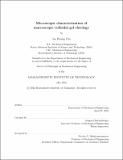| dc.contributor.advisor | Bischofberger, Irmgard | |
| dc.contributor.author | Cho, Jae Hyung | |
| dc.date.accessioned | 2022-08-29T16:25:12Z | |
| dc.date.available | 2022-08-29T16:25:12Z | |
| dc.date.issued | 2022-05 | |
| dc.date.submitted | 2022-06-23T15:04:13.716Z | |
| dc.identifier.uri | https://hdl.handle.net/1721.1/144982 | |
| dc.description.abstract | When attracted to one another, colloids, particles of size ranging from a few nanometers to a few microns suspended in a liquid, form a colloidal gel. The squishiness of a colloidal gel stems from its elastic space-spanning network of aggregated particles in a viscous liquid, which allows the gel to resist deformations like a solid under low stress, but to flow like a liquid under high stress. Owing to such mechanical versatility, colloidal gels are found in every corner of our lives as personal care products, dairy products, pharmaceuticals, and construction materials. Colloidal gels composed of functionalized particles are utilized for novel energy storage devices and biomedical applications. Engineering the mechanical behaviors of colloidal gels, however, remains a challenge due to our limited understanding of the link between microscopic particle interactions and macroscopic rheological properties. The state of thermodynamic nonequilibrium and the structural disorder of the network due to kinetic arrest of the attractive particles call for comprehensive investigation of colloidal gel rheology. In this thesis, we develop a better physical understanding of key rheological characteristics of a model colloidal gel via optical microscopy and rheometry. We employ differential dynamic microscopy to quantify the thermal fluctuations of the gel network across multiple length and timescales and rotational rheometry to characterize macroscopic strain and stress responses under shear. Use of the two complementary techniques enables us to show how the elasticity, the viscoelasticity, and the viscoplasticity of the gel on macroscopic scales arise from the microscopic structure and dynamics of the gel network while addressing different stages of the system from its gelation to yield or fluidization. Our findings suggest ways to systematically control the deformation and the flow of colloidal gels by tuning particle interactions or by adjusting external loadings. | |
| dc.publisher | Massachusetts Institute of Technology | |
| dc.rights | In Copyright - Educational Use Permitted | |
| dc.rights | Copyright MIT | |
| dc.rights.uri | http://rightsstatements.org/page/InC-EDU/1.0/ | |
| dc.title | Microscopic characterization of macroscopic colloidal gel rheology | |
| dc.type | Thesis | |
| dc.description.degree | Ph.D. | |
| dc.contributor.department | Massachusetts Institute of Technology. Department of Mechanical Engineering | |
| dc.identifier.orcid | https://orcid.org/ 0000-0002-2026-4121 | |
| mit.thesis.degree | Doctoral | |
| thesis.degree.name | Doctor of Philosophy | |
